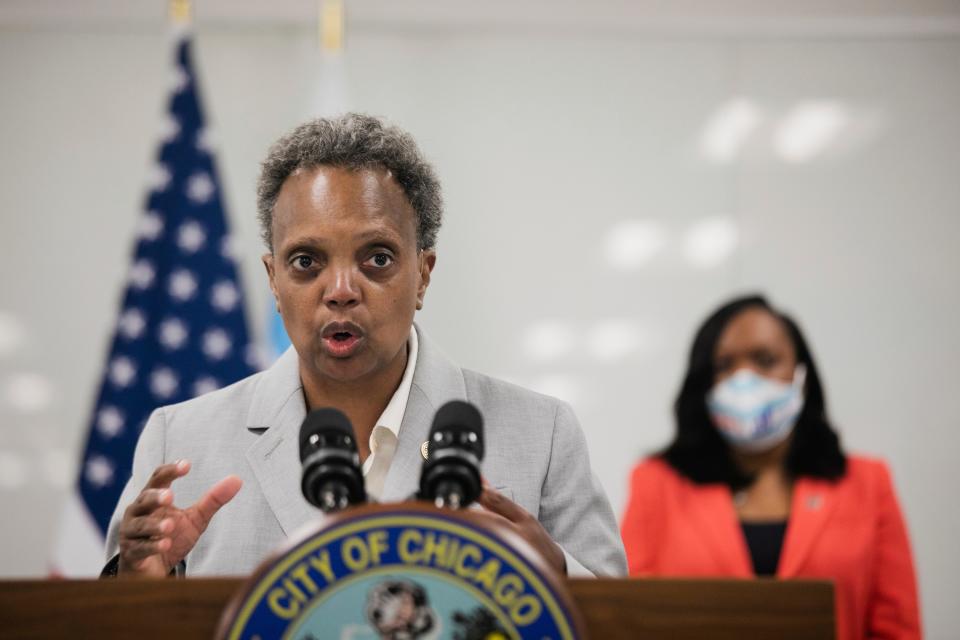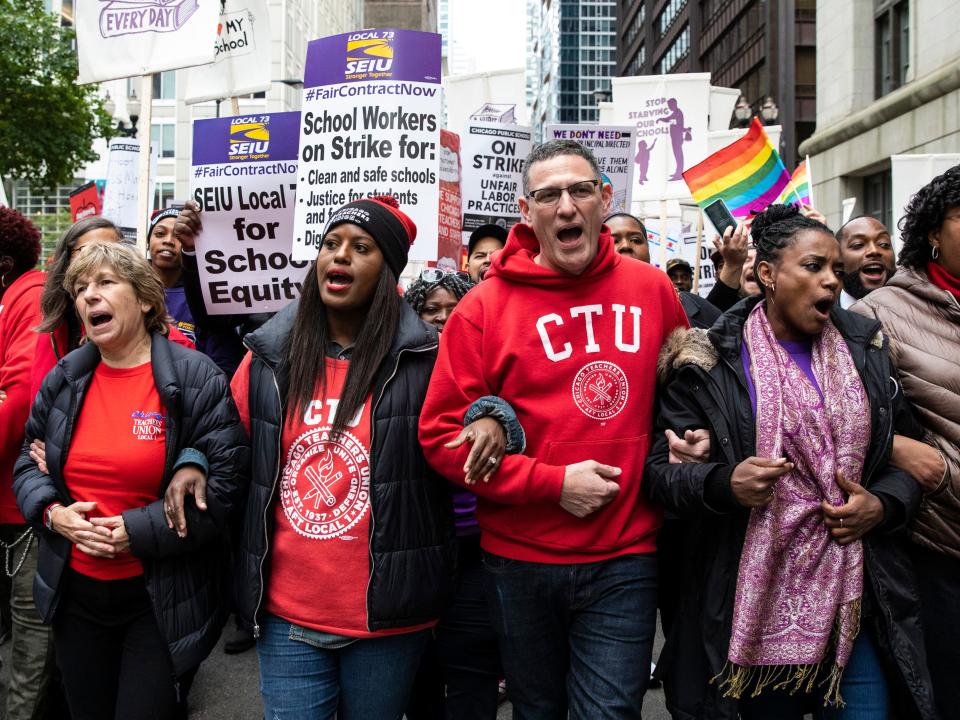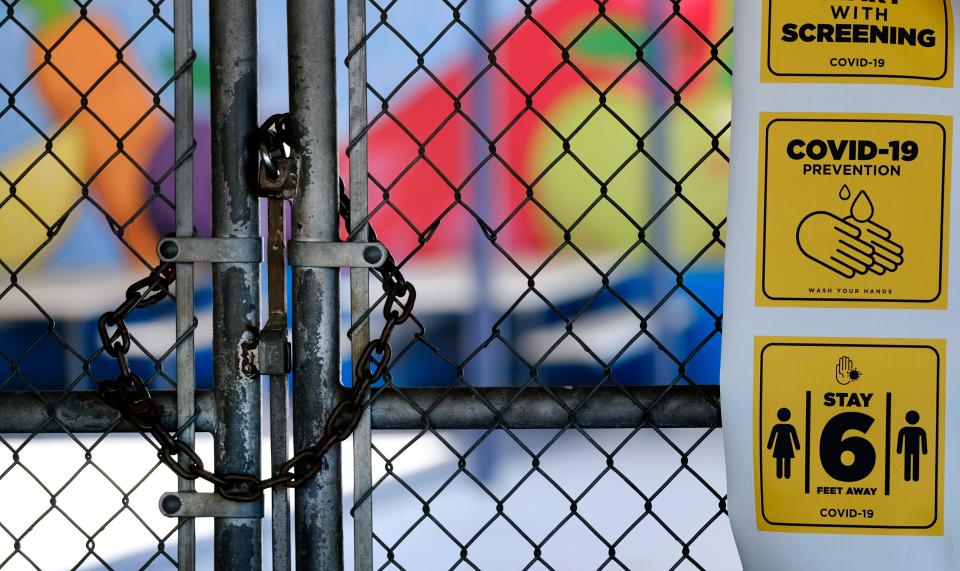Trump says open schools. Teachers say safety first. As cases rise, unions may win.
Chicago teachers piled into hundreds of cars on the first Monday of August and rolled their way to City Hall.
No strangers to large demonstrations, the teachers spent hours protesting Chicago Public Schools' plan to mix in-school and at-home learning this fall to reduce crowding in buildings amid the coronavirus pandemic.
Staff didn't feel safe teaching in person, the educators said, especially given rising rates of positive COVID-19 cases in Illinois. The demonstration had hallmarks of the massive strike the Chicago Teachers Union waged 10 months prior during a contract dispute with the city.
As union members murmured about potentially striking again for their safety, Mayor Lori Lightfoot announced Chicago's near 400,000 students would start the year online-only on Sept. 8. That means almost all of America's biggest districts will start the school year with online learning – a move largely driven by local teachers unions.

Emboldened by strikes and walkouts for more pay and greater respect in 2018 and 2019, unions have become a powerful force in shaping school reopening plans amid the coronavirus pandemic. They have pressed for a return with virtual learning to ensure the health of staff, students and families in places where virus cases are still high – and where districts can't ensure physical distancing and other safety measures that help mitigate the spread of the virus.
Among the largest districts, only New York City is planning to open with some in-person instruction – and a wing of its United Federation of Teachers is fighting that move.
Critics say teachers are shirking their duties as front-line workers. Doctors and grocery store staff have worked during the pandemic, they say, and getting kids back to class is paramount to make up for learning losses and to help the economy. But as more early-start schools see reports of new infections, some of the unions' dire predictions are being realized.
COVID by ZIP code: Parents torn as some schools face greater reopening risks
How long they can hold the line on at-home learning is unclear. Even if coronavirus cases remain high, parents' tolerance for managing their children's education while trying to work from home may wane again. Will unions risk losing public support if they continue to advocate for virtual education? How will they ensure the experience is more productive than in spring – especially since many unions have mere weeks to negotiate work rules related to online learning?
"If unions message this properly, it will carry the concern to parents: 'There’s no plan. There are no resources. Nobody is helping us out,'" said Linda Kaboolian, a fellow at Harvard Law School's Labor and Worklife Program. "If they don’t position it properly, it will look selfish."
'Don't open a school if infection rates are high'
As of early August, 17 of the country's 20 largest school districts totaling more than 4 million students planned to start the year with remote learning until conditions in the community improve, according to data tracked by Education Week magazine.
Community transmission rates is one of the most important issues to consider when reopening classrooms, said Tina Q. Tan, a professor of pediatrics at Northwestern University who specializes in infectious diseases.
"You don't open a school if infection rates are high," she said in a webinar with education reporters Wednesday.
But how low should they be? Surgeon General Jerome Adams said at the end of July that communities should have coronavirus positivity rates under 10% before schools reopen, but he also said there's no hard cutoff, according to an interview on CBS' "Face the Nation."
Kentucky's state teachers union said last week in-person instruction would be unsafe until COVID-19 positive case rates stay below 4%. Kentucky's positive rate of tests recently ticked up to almost 5.9%.
In New York, Gov. Andrew Cuomo announced last week that districts statewide could choose to start in-person as long as their positivity rate was under 5%.
Green light: New York schools OK'd for in-person classes.
Meanwhile, unions in Utah, Tennessee and other states with higher rates have pleaded with their governors to abandon or delay plans for in-person instruction.
The American Federation of Teachers, the nation's second-largest teachers union, recently took the unusual step of authorizing locals to strike if their district couldn't ensure the necessary precautions for reopening in person. Some of those would include masks, social distancing, frequent hand-washing, regularly disinfecting surfaces and keeping students in the same cohorts as they learn over weeks or months, as recommended by the Centers for Disease Control and Prevention.
Randi Weingarten, president of the AFT, said teachers would prefer to work with students in person. The AFT released a plan in early summer for how to safely reopen schools, but as virus cases have spiked, it's become increasingly clear that many districts can't afford or enforce the necessary precautions, she said.
Consider Avon Community Schools outside of Indianapolis. The district welcomed all students back on July 29. Within two weeks, multiple students and staff had tested positive for the virus, and hundreds of students had to quarantine as a result, said Suzy Lebo, a teacher at Avon High School and president of the local teachers union.
Back to school infections: Avon Community Schools has identified 9 cases of COVID-19
Lebo now wishes she and her colleagues had fought harder against the district's plan for reopening in-person school.
"We're not able to socially distance in our classrooms at all," she said.
At least 97,000 children in the U.S. tested positive for the coronavirus in the past two weeks of July alone, according to a new report from the American Academy of Pediatrics and the Children’s Hospital Association. Data from the report shows that more than 338,000 children in the U.S. have been infected since the pandemic began.
Children: Hostages or political pawns?
Teacher union critics, who tend to lean conservative, accuse the labor organizations of political posturing and over-dramatizing the risks of returning to class.
That's partly because some union members demonstrating against reopening classrooms have used the moment to call for more federal money for public schools and for a ban on charter and voucher programs and/or for police-free schools, as part of continued protests about police brutality against Black and brown communities.
"Rather than work to open schools safely, the unions are issuing ultimatums and threatening strikes until they are granted their ideological wish list," said a recent Wall Street Journal editorial. "Children, who would have to endure more lost instruction, are their hostages."
President Donald Trump has pushed for America's schools to reopen for in-person instruction and threatened to withhold federal aid for those that didn't even as COVID-19 cases have risen this summer. Education Secretary Betsy DeVos joined the call, abandoning her long-held philosophy of parent choice and decision-making at the local level.
No relief:Trump threatens to withhold funding to schools if they don't reopen
Trump appeared to soften his stance somewhat Wednesday with the release of recommendations stressing a "safe reopening" of schools, which reiterated advice from the CDC. Trump also said the government would send up to 125 million reusable masks to schools.
The American Academy of Pediatrics last month stressed the importance of returning kids to classrooms, noting the social, physical and emotional costs of staying at home. But the group then clarified its stance, stressing that the reopening must be done safely, following the advice of local health experts.
But the push to reopen, which many conservatives tie to improving the economy and bolstering Trump's chances of reelection in November, is still strong in many states. And unions in those places are gearing up for a fight.
In Florida, the state teachers union has sued the Gov. Ron DeSantis administration over an order requiring schools to fully reopen for in-person instruction. The union argues that violates the state constitution, which requires safety and security in public schools.
In Indiana, the state teachers union is protesting the governor's threat to withhold state aid for schools that don't reopen classrooms this fall.
"As cases of COVID-19 surge across the state, particularly in Black and Brown communities, tying school funding to in-person reopening is not only reckless, it's a brazen political move right out of Donald Trump, Mike Pence and Betsy DeVos' playbook," the president of Indiana's state teachers union, GlenEva Dunham, said in a statement.
"We cannot play politics with the lives of our students."
Science says: Kids less likely to die from coronavirus, but schools could become hot spots for spread
How safe is in-person learning?
Chicago is scheduled to offer remote instruction through the end of the first quarter, which ends Nov. 8. After that, the district is seeking to implement a hybrid model for most students: two days of in-person instruction and three days of remote learning, said Jesse Sharkey, president of the Chicago Teachers Union.
That plan presumes that infection rates in the area will be under control by then. If that's not the case, teachers unions still pushing for remote instruction may risk losing some public support, depending on how confident parents feel about returning their kids to classrooms.
Throughout 2018 and 2019, the public largely supported teacher walkouts and strikes across the country that called for higher wages for educators, more funding for classrooms and more respect and support for teachers and lower-paid school staff.
Now, a lot of older teachers may not want to come back to school in order to protect their own safety, said Lesley Lavery, an associate professor of political science at Macalester College in St. Paul, Minnesota, who studies union-district relationships.
But teachers, pediatricians and economists all agree that in-person learning for students is optimal and that the inequities that already exist in education are difficult to address virtually.
"This is a rare instance where teachers and students’ interests may be at odds," Lavery said. "But for the most part, safety measures would benefit everyone."
Sharkey noted that many teachers are parents, which means they're uniquely positioned to know what does and doesn't work for kids.
"We continue to argue that the virus and the science should dictate when (Chicago) schools return to any form of in-person learning, especially since transmission and disease in children – particularly younger children – is not yet well understood," he said.

Becky Pringle, the new president of the National Education Association, which represents 3 million members, said it's not safe to go back into schools if infection rates haven’t gone down in a region, or if schools don’t have a plan to isolate students and educators who contract COVID-19.
"If (students) are sick or they make their parents sick or someone dies? That’s as basic as it gets," Pringle said.

The nation's largest district, New York City schools, stands alone among the seven largest U.S. districts in still planning for a hybrid model of instruction, with kids learning in school two or three days a week and at home on the other days. City leaders believe that's possible because infection rates have remained low.
New York's schools are scheduled to reopen on Sept. 10, and there's much to figure out before then. And there's still time for leaders to change their minds.
Little time to improve online learning
Battles over opening in-person or remotely are leaving little time for districts and unions to negotiate how to improve virtual learning, which will be critical for millions of children learning fully or partially online.
How teachers do their work online should be negotiated in districts with bargaining agreements – but that rarely happened when schools moved online in mid-March, said Brad Marianno, an assistant professor of education policy and leadership at the University of Nevada, Las Vegas.
Only one in four large urban districts in spring signed off on formal agreements with their unions about work expectations for online learning, he said. The lack of clarity around teachers' work led to a chaotic experience for many students and parents.
In some districts this spring, unions told teachers not to work until administrators formed a virtual learning plan. That resulted in students losing even more days of instruction.
Many districts want teachers to conduct more live instruction via videoconference this fall. But some unions have sought to limit the time teachers are online.
In Highline Public Schools, located just south of Seattle, Washington, Superintendent Susan Enfield said their 18,000 students will start the year online this fall.
Students who can't tune into live lessons, perhaps because there aren't enough devices in the home, need to have a way to access them later, she said. But recording live lessons had been a sticking point with the union because of privacy issues.
But now, Enfield said, teachers and the district are working toward an agreement.
In Los Angeles, one of the first large districts to announce it would start the year virtually, union and district officials recently agreed to a deal that requires teachers to teach via live video every day. In spring, Los Angeles teachers were required to be online with students only for a few hours each week.

Student attendance will be taken for each class, which also reflects heightened expectations from spring. Teachers will have the option of working from their classrooms, but students will log on from home.
Grading policies are still being negotiated, said Los Angeles teacher Marisa Crabtree, who teaches at Lincoln High School.
Los Angeles teachers will start Aug. 17 with three days of staff collaboration and planning before reuniting with students virtually on Aug. 20.
Crabtree said that's more time than teachers are usually paid to plan and prepare for the year. She's not sure it's enough, but it's an improvement, she said – and a recognition that opening schools this year is far different from any other fall.
Education coverage at USA TODAY is made possible in part by a grant from the Bill & Melinda Gates Foundation. The Gates Foundation does not provide editorial input.
This article originally appeared on USA TODAY: With COVID cases rising, teachers drive back-to-school reopening plans

